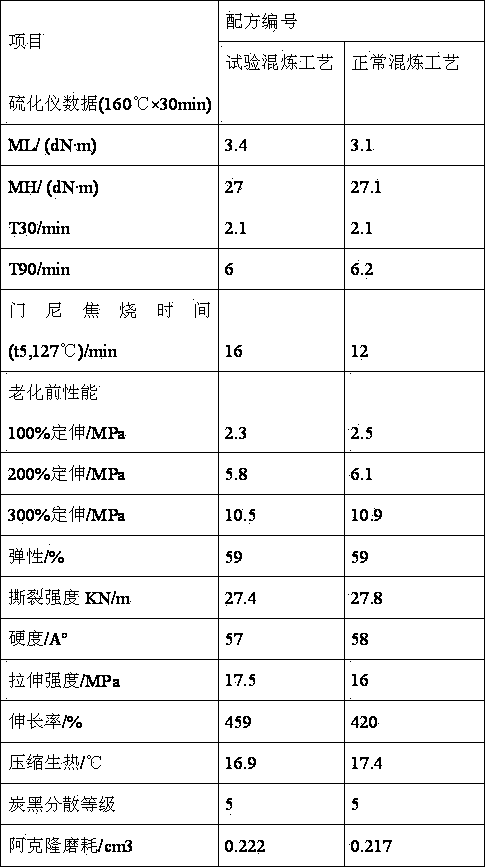High-temperature-resistant strong-resilience high-safety mixed rubber
A technology of resilience and compound rubber, which is applied in the field of compound rubber and its technology
- Summary
- Abstract
- Description
- Claims
- Application Information
AI Technical Summary
Problems solved by technology
Method used
Image
Examples
Embodiment 1
[0028] (1) Preparation of gel: add 5% polyisoprene, 4% polybutadiene, 1% dimethyl hydroxy silicone oil, and 10% diphenylsilanediol to an autoclave at 60°C. Then the mixture was stirred at 60° C. for 2 hours under a nitrogen atmosphere, then heated to 150° C., stirred at this temperature for 45 minutes, so that the swelling index of the gel particles was 5, and the particle size was 60 mm, and cooled;
[0029] (2) Mixing rubber: add a certain amount of methyl vinyl silicone rubber 10% in the kettle reactor, pass through nitrogen to heat and vacuum dehydrate for 2 hours, add 3% methyl vinyl cyclotetrasiloxane, The catalyst composed of diethylaluminum chloride, ethylaluminum chloride and methylaluminoxane is 2%, and the temperature is raised to 150°C to start the reaction. When the viscosity increases and becomes paste, reduce the stirring speed until the stirring is stopped. The free growth of the molecular chain of the product, the reaction is over within 2 hours, and the glue ...
Embodiment 2
[0034] (1) Gel preparation: Add 10% polyisoprene, 4% polybutadiene, 3% dimethylhydroxy silicone oil, and 8% diphenylsilanediol to an autoclave at 60 °C. Then the mixture was stirred at 60° C. for 2 hours under a nitrogen atmosphere, then heated to 150° C., stirred at this temperature for 45 minutes, so that the swelling index of the gel particles was 5, and the particle size was 60 mm, and cooled;
[0035](2) Mixing rubber: add a certain amount of methyl vinyl silicone rubber 10% in the kettle reactor, pass through nitrogen to heat and vacuum dehydrate for 2 hours, add 3% methyl vinyl cyclotetrasiloxane, Catalyst 2% composed of titanium tetrachloride, tin tetrachloride and methyl aluminoxane, start the reaction at 150 ° C, when the viscosity increases and becomes paste, reduce the stirring speed until the stirring is stopped, with the polymer molecular chain Free growth, the reaction ends within 2 hours, and gelation occurs after 2 hours of equilibrium;
[0036] (3) One-stage...
Embodiment 3
[0040] (1) Preparation of gel: Add 6% polyisoprene, 4% polybutadiene, 2% dimethyl hydroxy silicone oil, and 82% diphenylsilanediol to an autoclave at 60°C. Then the mixture was stirred at 60°C for 2 hours under a nitrogen atmosphere, then heated to 150°C, stirred at this temperature for 45 minutes, so that the swelling index of the gel particles was 5 and the particle size was 60 mm, and cooled;
[0041] (2) Mixing rubber: add a certain amount of methyl vinyl silicone rubber 10% in the kettle reactor, feed nitrogen to heat and vacuum dehydrate for 2 hours, add 4% methyl vinyl cyclotetrasiloxane, The catalyst composed of ethylaluminum chloride, titanium tetrachloride and tin tetrachloride is 2%, and the reaction starts at 150°C. When the viscosity increases and becomes paste, reduce the stirring speed until the stirring is stopped. With the polymer molecular chain Free growth, the reaction ends within 2 hours, and gelation occurs after 2 hours of equilibrium;
[0042] (3) One-...
PUM
| Property | Measurement | Unit |
|---|---|---|
| tensile strength | aaaaa | aaaaa |
| elongation at break | aaaaa | aaaaa |
Abstract
Description
Claims
Application Information
 Login to View More
Login to View More - R&D
- Intellectual Property
- Life Sciences
- Materials
- Tech Scout
- Unparalleled Data Quality
- Higher Quality Content
- 60% Fewer Hallucinations
Browse by: Latest US Patents, China's latest patents, Technical Efficacy Thesaurus, Application Domain, Technology Topic, Popular Technical Reports.
© 2025 PatSnap. All rights reserved.Legal|Privacy policy|Modern Slavery Act Transparency Statement|Sitemap|About US| Contact US: help@patsnap.com

